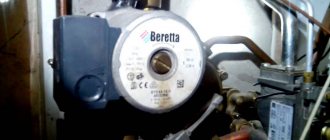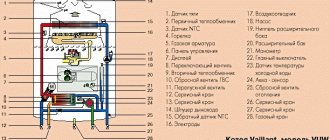Home / Gas boilers
Back
Published: 06/07/2019
Reading time: 5 min
0
3590
Installation of heating in household plots, in the absence of central heating systems, is carried out taking into account the available natural fuel in the region of location and its price.
Based on these criteria, today the cheapest source is gas, which makes the AOGV gas boiler one of the most promising types of individual heating.
The advantages are enhanced by the fact that such devices are easy to operate due to the absence of the need to load coal fuel, while ensuring complete combustion and protecting the environment from harmful emissions.
- 1 Decoding of AOGV
- 2 Advantages of AOGV boilers
- 3 Design and technical characteristics
- 4 Operating principle
- 5 Boiler manufacturers AOGV
- 6 Brief overview of models
- 7 Maintenance
General characteristics of AOGV boilers
The abbreviation AOGV stands for Gas Water Heating Unit.
Different manufacturers in the instructions for this technique allow for minor nuances and differences in the decoding of its name, but this does not affect the overall meaning.
If the letters of the name are followed by numbers, they indicate the power of the device.
Efficiency and temperature
If you plan to choose a heating boiler that guarantees maximum efficiency, then purchasing an AOGV is an absolutely justified step. It produces about 92% of maximum efficiency, which was achieved thanks to the special design of the heat exchanger.
These devices are used in heating systems operating using forced or natural movement of coolants. The main condition for the normal functioning of AOGV gas boilers is atmospheric pressure in the system, which does not exceed 1.4 atm. The operating temperature range of these heating devices is from 40 to 90 degrees.
Power
Modern boilers of the AOGV type have been known on the Russian market for about 15 years. As a rule, they are designed to heat rooms with a total area of about 200 square meters. and have a power of up to 30 kW. It is not practical to use such devices for heating rooms with a small area (less than 100 sq. m.).
These heating boilers are considered energy-independent and operate exclusively on the basis of natural gas.
Most often they are produced in a floor-standing version. The following models are most widespread on the domestic market:
- comfort;
- station wagon;
- economy
The choice of type of heating device depends on its price category and the size of the room.
Advantages and disadvantages of AGV
The list of positive qualities of AGV is as follows:
- Independence from electricity. This quality is often fundamental when choosing an AGV. The equipment in question does not require electricity at all to operate, so it will fit perfectly in situations where there are problems with electricity, or if there is a desire to save money on it.
- Cheapness. Compared to any foreign analogues, AGV wins in everything related to the cost of equipment. This advantage remains such even taking into account the extremely low efficiency of autonomous gas water heaters.
- Economical. AGVs are rightfully considered one of the most economical types of gas heating equipment.
The disadvantages of AGV come down to the following list:
- Big sizes. To install an AGV, about 1 m3 of space is required - which is quite a lot. Often a separate room is allocated for the installation of such equipment.
- Appearance. From a visual point of view, AGV is a purely utilitarian thing that does not have the slightest aesthetic value. In addition to the unpresentable appearance of the heater itself, the heating system is necessarily supplemented by large pipes and radiators, so you have to be sophisticated to create a good interior.
AGV heating - what is it?
The interpretation of AGV is as follows: gas water heating device. As you already understood, such a device is a water heating heating device, the fuel for which is gas.
Gas is still one of the most economical resources. This is why many people choose gas boilers for individual heating at home.
This device has excellent technical characteristics. It is very economical and easy to maintain. Also in its favor is the fact that it can work for a long time without human intervention. That is why many owners of private houses have not yet replaced such heating with a more modern one.
AGV gas boilers have a number of advantages over other domestic boilers. Therefore, they have not yet been discontinued and are popular.
Advantages of AGV:
- Low cost;
- Cost-effective;
- Ease of maintenance;
- Independence from electricity.
These advantages are quite important. However, in contrast to them, old AGVs also have a number of disadvantages.
Disadvantages of AGV:
- Low efficiency;
- Small heating area;
- Rapid wear of automation;
- Pipes leading to the boiler directly along the walls.
Despite these advantages, AGV boilers are still popular. Many are attracted by their low cost and efficiency. Well, for houses whose area is less than 100 meters, this is really a good option.
Operating principle of AGV
The main structural element of the AGV is the container in which the coolant is heated. When gas burns, a heat exchanger, made in the form of a pipe and installed inside the AGV housing, heats up. The heat from the heated pipe is transferred to the coolant, which is subsequently sent to the heating circuit.
Gas combustion products are discharged through a chimney built into the boiler design. All automation is a valve that opens the gas burner. Thanks to the operation of the valve, the required temperature is constantly maintained in the tank.
AOGV boilers also have an automation unit that turns off the device in case of a number of problems:
- Traction disorder;
- Significant reduction in gas supply pressure;
- The igniter stops burning.
Immediately behind the AGV, the following elements of the heating system are installed sequentially:
- Expansion tank;
- Heating devices located in each room requiring heating;
- Main pipeline providing distribution of heated coolant;
- Upper pipe distribution;
- Return pipe.
To know how an AOGV gas boiler works, you need to imagine the physical laws that arise in the heating system during its operation. The heated coolant has a lower density, which allows it to independently rise above the cold liquid. The coolant enters the main pipeline, is carried through the heating devices, gives off heat to them, and returns to repeat the heating cycle.
In AOGV boilers, the liquid moves by gravity, without any additional effort. If during the heating process the coolant expands too much, then its excess is drained into the expansion tank. This element is installed on the uppermost section of the heating circuit. When the temperature in the circuit decreases, the coolant returns to the OGV gas boiler.
To increase the efficiency of the system and make it more stable, you can supplement the AGV with a circulation pump, which forces the coolant to move forcibly and ensures more uniform heating of all sections of the circuit. It must be remembered that the pump requires electricity to operate - and the main advantage of the AGV is its independence from electricity.
Advantages and disadvantages of Zhukovsky gas boilers
The popularity of AOGV gas boilers for private houses and apartments is due to a number of advantages that users appreciate.
Advantages of Russian technology:
- Easy controls that provide safe and simple temperature settings within certain limits.
- The use of innovative technologies ensures maximum accuracy and error-free operation reliability.
- The boiler is energy independent and therefore does not need to be connected to the power supply network.
- The equipment is compatible with polypropylene, cast iron, steel and other materials.
- There are modifications in which it is possible to turn off the gas yourself, this increases safety in the event of an accident or failure of automatic devices.
- The heat exchanger is durable and reliable.
- The AOGV gas boiler is not afraid of natural gas fluctuations.
- The coolant temperature can be adjusted manually.
- Service life is 14 years or more.
- Manufacturer's warranty for 36 months.
All gas boilers from the Zhukovsky plant have one circuit and are intended only for heating. However, please note: some similar models from other manufacturers may be equipped with a second circuit for heating water for domestic needs.
These units have high-quality thermal protection, ensuring the most complete recycling of the energy of the used gas.
AOGV gas boilers are environmentally friendly. They emit a minimum of harmful substances into the atmosphere after complete combustion of the gas, all thanks to the design of the micro-flare burner.
Another important fact is that such units are adapted to the climate conditions in Russia.
Disadvantages of units:
- Considerable cost of these boilers in comparison with some analogues.
- Certain difficulties when finding spare parts.
- Automation of outdated configurations on some modifications.
- Large boiler dimensions.
- Some people may find the external design of the boiler equipment casing unattractive.
Gas boilers AOGV from JSC Borinskoe
The Borinsky plant produces rectangular heaters, with automation in the rear.
The second most popular manufacturer of AOGV is the Borinsky plant. It offers 7, 11, 17, 23 and 29 kW heaters. Such a wide range allows you to choose a boiler even for a small house up to 70 sq. m. This is convenient when there is no point in overpaying for a more powerful unit. At the same time, the Zhukovsky plant can offer customers gas boilers AOGV 11.6 - this is the minimum value.
The Borinsky plant produces two modifications of heaters:
- normal - single-circuit;
- combined - double-circuit.
Boiler burners are made of stainless steel. Copper DHW heat exchanger. The heater body is painted with polymer paint. The unit has built-in temperature regulators to prevent it from overheating, a thermocouple to control the gas supply, and a draft stabilizer. The latter smooths out differences during strong gusts of wind, and in the event of a complete lack of traction, it blocks the gas supply and, accordingly, the operation of the unit. Natural or liquefied gas is suitable as an energy carrier.
Operating principle of AOGV
All AOGV units are equipped with a built-in atmospheric burner. At the bottom of the structure, directly under the tank with a heat exchanger, a burner is installed, which is responsible for heating the water. When converting the device, it can be operated on bottled gas.
Construction of the AOGV gas boiler at the Zhukovsky Machine-Building Plant
The steel heat exchanger has a tubular design, which contributes to a high efficiency. At the back of the structure there are outlet and inlet fittings with a diameter of about 4 cm. They are necessary for connecting the coolant. The return line is located at the bottom, and the “direct” line at the top.
The chimney has a diameter of about 120 mm and is connected to the top of the boiler.
The boiler is controlled by a valve that has electromagnetic properties, as well as a thermostat lever. Units with piezo ignition or autostart are often produced. A thermocouple and a draft sensor are connected to the valve.
A copper thermocouple regulates the flame on the igniter and is one of the main elements of boiler equipment. The traction sensor shuts off the gas when the traction weakens.
Installation of AOGV in a heating system
AOGVs are installed in private homes.
Installing an AOGV in a private house will cost one and a half times less; on average, the cost of a heater is 20 thousand rubles. Such units can operate in both sealed and open systems. In the latter case, the circuit depends only on the gas supply; there are no energy-dependent devices in the boiler.
The do-it-yourself installation scheme for AOGV in a private house is standard. Consider a sealed circuit:
- the supply from the boiler goes straight to the radiators (air vents must be installed in them);
- a pump is placed on the return line in front of the boiler - installing a pump is allowed in any place, but on the return line it is more correct;
- A mud trap is placed in front of the pump along the coolant flow - this is mandatory;
- The expansion tank is also installed before the pump - this is necessary for the correct operation of the expansion machine.
In an open system, the expansion tank plays the role of an air vent. It can be placed on the supply, immediately above the boiler, or on the return. The main thing is that it is at the highest point. In gravity systems, certain slopes must be observed, then an electric pump is not needed. If the circulation in an open circuit is disrupted, then installing a pump will easily solve this problem; you can even not replace the expansion tank with a sealed one.
Installation features
To protect flammable surfaces, a sheet of metal is nailed to the walls and floor.
In order for the OGV units to work properly after installation, the following recommendations of specialists are followed:
- if possible, it is better to install the heating element in a separate room;
- for floor options you will have to build an additional reinforced foundation;
- the diameter of the chimney should not be less than 14-15 cm, and its height – 5 m;
- the smoke exhaust pipe must be additionally insulated to prevent condensation from appearing inside;
- if the design has an open combustion chamber, the room is equipped with forced ventilation;
- a sheet of metal measuring 1*1 m is nailed to the floor in front of the boiler;
- the minimum distance from the walls during installation is 20 cm, and all surfaces must be treated with non-flammable material.
AOGV is a floor or wall heating unit that works equally well both in a private house and in an apartment. However, the choice of equipment must be made correctly. It is better not to select high-power devices for small structures, as this will lead to unnecessary fuel consumption.
AGV modifications
Considering the variety of modifications of gas water heating devices on the market, it is worth understanding how the AOGV differs from a gas boiler. Looking ahead a little, there is no fundamental difference between the devices; all the differences lie in small nuances.
If we talk in detail, then everything that distinguishes an AOGV from a boiler comes down to the following points:
- Glass thermometers have been replaced with modern Italian components;
- Honeywell products began to be used as automation elements;
- The design is supplemented with a piezo ignition device;
- The last difference between the AOGV and the boiler is that the appearance of modern modifications has been slightly improved, for which a higher quality coating has been used.
How it all began
At one time, gas boilers of the AGV-80 or AGV-120 brand were used to heat a private house. This equipment had low productivity, but given the low cost of gas, this fact did not bother anyone.
AGV gas boilers for private homes were equipped with primitive automation, which failed in the first year of operation. However, the equipment functioned normally without it.
Installation of pipes for distribution is carried out outside around the perimeter of the house. However, this issue was not relevant at that time, and heat was supplied to the house in full. Pipes were used with a diameter of 2 inches, since a smaller diameter could cause the formation of air pockets that impede the natural circulation of the coolant.
After a slight modernization, gas boilers for heating AOGV and AOKGV appeared on the market, but this equipment was characterized by the same shortcomings (low performance and unreliable automation).
Despite this, boilers of this type have held up quite confidently on the market due to a serious advantage: the AGV heating stove operates without being connected to a power supply.
Other advantages of a heating system using AGV include the following:
- If we compare imported equipment and AGV, we note the affordable cost of the latter option.
- In contrast to the AOGV and the gas boiler produced by domestic manufacturers, the efficiency of the AGV can be noted.
The listed characteristics help in deciding what is better: an AOGV or a boiler.
Energy and energy equipment
Research Institutes of Energy Energy companies Energy saving technologies Sale of heating boilers Repair of heating boilers Cleaning of boilers and heat exchangers Design and construction of boiler houses Boiler equipment - production, sale, repair Construction of energy facilities Construction, repair and maintenance of energy facilities Power plants - equipment Diesel power plants, sale RusHydro Pipes and pipeline fittings Electrical installation work Cable industry enterprises Electrical products, sales Gas industry, gas equipment Oil and gas industry - enterprises in Moscow Sale and transportation of petroleum products Petrochemical enterprises Energy audit Energy equipment Air conditioners and fans, sales Electrical goods stores Leroy Merlin electrical goods
Boilers of these brands are produced
by the Zhukovsky Machine-Building Plant (ZhMZ)
, the largest enterprise in Russia producing household gas heating boilers.
Therefore, these boilers are often called Zhukovsky
.
ZhMZ is located in Zhukovsky, Moscow region. Since 1967, the plant began producing household heating boilers AGV-120, widely known in all regions of Russia and the CIS countries. Currently, the plant produces more than 30 types of AOGV, AKGV and KOV with power from 11 to 68 kW. Zhukovsky boilers are used in electrically independent autonomous water heating and water supply systems. New modern equipment and highly qualified personnel allow us to produce competitive products and the plant to be the Russian leader in the production of gas equipment for autonomous heating and water supply systems. Boiler AOGV-17.4 Gas floor-standing boilers AOGV
are used for heating residential buildings and domestic premises in heating systems with natural or forced water circulation.
The boilers are single-circuit and are used only for heating. For hot water supply, a double-circuit analogue is used - AKGV boilers
.
The abbreviation “AOGV”
stands for
“Gas Heating Unit”, “AKGV - “Combined Gas Unit”.
Those. The AOGV boiler is used only for heating, while the AKGV boiler allows for the selection of hot water for domestic needs. The boilers operate on natural gas, and when replacing nozzles (on the main burner and igniter) - on liquefied (cylindered) gas. The boiler heat exchanger is steel. It has a special design that allows achieving a boiler efficiency of at least 89%. The model range of AOGV boilers includes devices with a power from 7 to 23.2 kW and allows you to heat rooms with an area of 25 to 200 m2. The AKGV boiler range includes devices with a power from 11.6 to 23.2 kW and allows you to heat rooms with an area of 50 to 200 m2. The distinctive qualities of boilers of these brands are simplicity and reliability of design, unpretentiousness, and ease of use. These qualities allowed the AOGV and AKGV boilers to gain popularity in Russia. The AOGV boiler can be found in many country houses and in houses with apartment heating. Gas heating boilers AOGV and AKGV can be used both in systems with natural circulation of coolant (open system), without connection to the electrical network, and in systems with forced circulation of coolant (closed system) with the installation of a circulation pump. Based on serial boilers AOGV and AKGV, it is possible produce modular boiler houses of various capacities When AOGV and AKGV boilers operate in the heating system, low-freezing liquids recommended for use in heating systems can be used as a coolant
Insertion of AOGV into heating
Since it is not difficult to include AGV in home heating, you can do it yourself, but you will first need permission from the utility services. The insert involves connecting the unit to the heating pipes, as well as to the gas main. To prevent scale particles and dirt from getting inside the boiler, coarse filters must be installed on the inlet pipes. All threaded connections are sealed using tow and O-rings.
Shut-off valves are installed on water pipes. Only a person who has permission to do this type of work can connect the boiler to the main gas line. The gas pipe is also connected with additional sealing. When connecting, copper products or corrugated hoses are used.
Rubber parts are not used because over time they crack and can leak gas, which, if accumulated in the room, will lead to disastrous consequences. A union nut is used to secure the corrugated hose.
Main operational characteristics of the AOGV and AKGV boilers
Boiler brandThermal power, kWAutomationHeating square, m2Weight, kgAOGV-7-3 AOGV (AKGV) -11.6-1 AOGV (AKGV) -11.6-1 SIT AOGV (AKGV) -17.4-1 AOGV (AKGV) -17.4-1 SIT AOGV (AKGV) -23.2-1 AOGV (AKGV) -23.2-1 SIT AOGV (AKGV) -23.2-1 SIT with Zhukovsky connection AOGV (AKGV) -29-1
| 7 | EUROSIT | 25-60 | 40 |
| 11,6 | Orion | 40-90 | 45 |
| 11,6 | EUROSIT | 40-90 | 45 |
| 17,4 | Orion | 70-140 | 50 |
| 17,4 | EUROSIT | 70-140 | 59 |
| 23,2 | Orion | 90-200 | 54 |
| 23,2 | EUROSIT | 90-200 | 54 |
| 23,2 | EUROSIT | 90-200 | 54 |
| 29 | Nova SIT | up to 250 | 58 |
Manufacturers of boilers AOGV and AKGV
.
The Boiler Equipment Plant OJSC Borinskoye
has been producing AOGV boilers for more than 15 years and during this time has made a number of significant changes to the basic design of the boilers. Improvements such as: •modern design of the heat exchanger and gas burner device, •increased efficiency, •possibility of installing a copper circuit, •use of imported automation, •polymer painting,
New generation of AGV devices
Russian factories produce AOGV - 23.2 - 1. This is a household heating gas cylinder. It is intended for heating houses with an area of 140 - 200 square meters. meters. There is also a device with slightly less power for heating an area of 100 - 140 square meters. m. Otherwise, these two types of heaters are practically no different from each other.
Recently, a more modern model AKGV - 23.2 - 1 with a water circuit has appeared. It can also be used to heat a home and supply hot water. And instead of a pipe running inside the boiler, three steel sections are installed, which are made using a special stamping method and are hollow inside. The sections are mounted vertically and are connected into one chimney, through which gas combustion products flow into a separate chimney pipe.
How to choose gas heating boilers?
New generation of AGV devices
Water is heated using a special coil, which encircles the entire circuit inside the boiler and the water that is used for everyday life flows through it. And in the boiler the water for heating is also heated. That is, it turns out that this device is two in one.
The new model includes an injection burner, which ensures efficient combustion of gas without residue. This type of burner works perfectly even when the gas pressure in the pipeline is low.
Automation of the new AGV
It completely controls the entire process of heating water. And the automation unit itself consists of:
- a temperature sensor that controls the water temperature;
- an electromagnet, which is responsible for controlling the main gas supply valve;
- thermocouple, which is mounted near the igniter. Heated by a constantly burning torch, it creates an electric current in the circuit;
- traction sensor. It is mounted in the chimney and controls the optimal draft of the pipe.
Generation of new heating systems
Modern models of gas boilers are more advanced in comparison with traditional analogues. Both single-circuit and double-circuit devices are available on sale. The first ones are intended only for heating.
The latter are capable of simultaneously performing two functions: heating the premises of the house and providing its owners with hot water supply.
Scheme: arrangement of single-circuit and double-circuit boilers
Innovations concern not only the design of the device itself, but the use of higher quality devices:
- The design now includes control and regulating devices that allow you to set different modes.
- In the ignition system, traditional handles have been replaced by piezoelectric elements.
- The casing coating is characterized by increased resistance to damage and durability.
They are convenient because they are able to operate smoothly and efficiently, without requiring constant human supervision. Sensors located on the body will indicate malfunctions, while at the same time identifying the system that has failed.
Thanks to the automatic AGV, in the event of a drop in gas pressure, unexpected extinguishing of the pilot flame and a decrease in draft, the system is instantly switched off, which is important for the safety of residents.
- The main elements of the automation unit are:
- Electromagnet – controls the gas supply valve;
- Thermal sensor – controls water heating;
- Draft sensor – monitors the draft level in the pipe;
- Thermocouple – creates an electric current in a circuit.
Modern boilers are as compact and automated as possible
The gas supply to the burner is controlled by a thermal sensor. To ensure uninterrupted operation of the unit, you just need to set the desired parameters. When the shutter is automatically activated, the gas supply to the burner is reduced to a minimum, and the operation of the system is maintained only by a weakly burning wick.
As soon as the temperature sensor triggers to lower the temperature of the coolant, the automation starts and the wick ignites.
Modernization of AGV boilers by the manufacturer
The boiler manufacturer AGV was in no hurry to discontinue them due to obvious advantages.
However, taking into account that this equipment needed a thorough modernization, the following design changes were made:
- Fragile glass thermometers have been replaced with more reliable instruments made in Italy;
- The new systems were equipped with automation from the American company Honeywell;
- To turn on the device with a handle, a piezo ignition system was used;
- New coating technology has made the appearance of the unit more aesthetically pleasing.
Boiler diagram AOGV - 23
Rules for handling the heating system
The unit is installed in a separate room. It is advisable that this room be soundproofed, since when the boiler burner is turned on, a rather loud bang occurs.
In some new modifications (AOGV-23.2-1-U), this drawback has been largely eliminated, since when the water overheats, the automation does not turn off the burner completely, but switches it to a mode in which the flame is minimal.
A chimney (with a diameter of 140 mm) for combustion products is installed outside residential premises. Below the junction of the pipe from the heating tank with the chimney, there is a garbage container - a “pocket” for foreign objects and waste that accidentally fell into the channel.
Option for a chimney for AGV in a private house
Note! You should not connect the unit yourself. It must be carried out by gas service workers. In this case, the device is registered.
For the unit, a room should be allocated in the lower part of the building. The ascending pipeline needs insulation. The return line should not be insulated.
The installation instructions for heat transfer devices (radiators, convectors and heating panels) provide for their installation at the highest possible height from the unit itself. To circulate layers of air, such devices should be installed under windows. The return pipeline is laid under the floor of the room.
If the return line is laid above the door jambs, airing of the system may occur.
General view of a fragment of the pipe layout of a heating system with AGV
Two-inch network pipes do not look very aesthetically pleasing, however, when replacing them with pipes of smaller diameter, it is necessary to take into account that as the diameter of the pipe decreases, hydrodynamic resistance increases, which weakens the water pressure in the system. This, of course, can seriously impair the performance of such a unit.
AOGV connection: rear view
During installation, pipelines are installed with a slope of 1 cm for each meter of pipe length. This avoids the appearance of air locks in the system, facilitates water circulation and allows water to be drained from the system.
This video examines some practical issues of installing AGV in a private home:
Some Caveats
- When the water temperature in the system drops below 55-50°C, condensate begins to release abundantly. If it accumulates, it can extinguish burners;
- Combustion products, when mixed with condensate, form nitric and sulfuric acids, which cause corrosion of equipment;
- If the water temperature in the system drops below 50°, then its circulation in the system almost completely stops;
- If the room is not heated in winter, the water from the system must be drained, but in this case corrosion increases significantly;
- To get hot water without heating the entire system, you can use a tap that shuts off the circulation in the heating system. And if you connect the forward and return lines, you can maintain turnover.
Have a warm winter!











